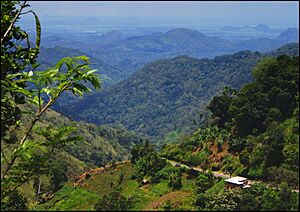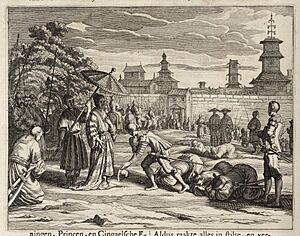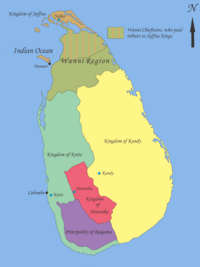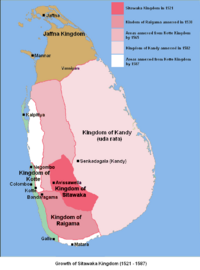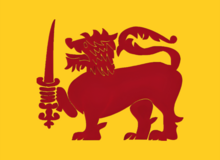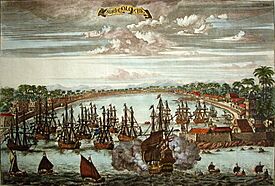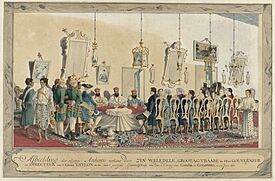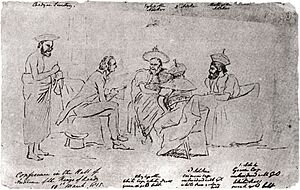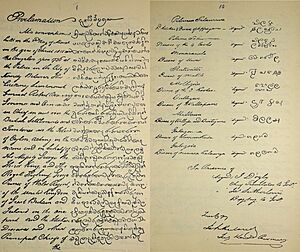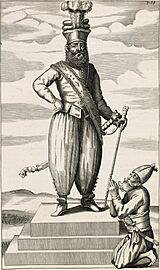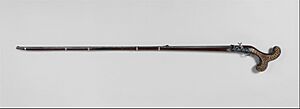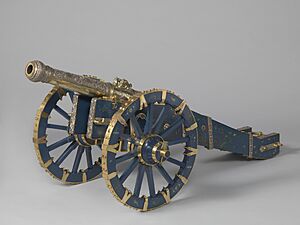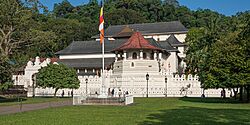Kingdom of Kandy facts for kids
Quick facts for kids
Kingdom of Kandy
මහනුවර රාජධානිය
Mahanuwara Rajadhaniya |
|||||||||
|---|---|---|---|---|---|---|---|---|---|
| 1469–1815 | |||||||||
|
Royal Standard
|
|||||||||
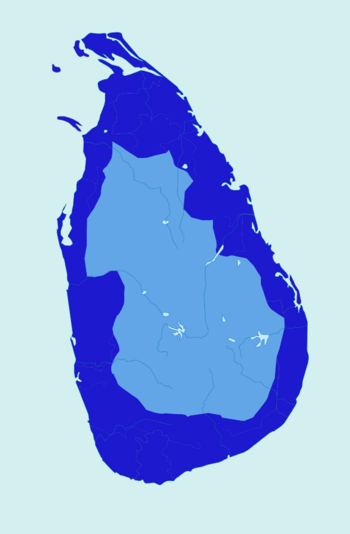
Territorial extent of the Kingdom of Kandy (1689–1796) Dutch-controlled areas
|
|||||||||
| Capital | Kandy | ||||||||
| Common languages | Sinhala (court language 1469–1815 and dynastic language 1469–1739) Tamil (court and dynastic language 1739–1815) Pali (for religious purposes) |
||||||||
| Religion | Theravada Buddhism, Hinduism | ||||||||
| Government | Monarchy | ||||||||
| Monarch | |||||||||
|
• 1469–1511
|
Senasammata Vikramabahu (first) | ||||||||
|
• 1798–1815
|
Sri Vikrama Rajasinha (last) | ||||||||
| Historical era | Kandyan period | ||||||||
|
• Foundation of Senkadagalapura
|
1469 | ||||||||
|
• Conquest by Sitawaka
|
1581 | ||||||||
|
• Ascension of Vimaladharmasuriya I
|
1592 | ||||||||
|
• Kandyan Convention
|
2–18 March 1815 | ||||||||
|
|||||||||
The Kingdom of Kandy was a powerful monarchy on the island of Sri Lanka. It was located in the central and eastern parts of the island. This kingdom was started in the late 1400s and lasted until the early 1800s.
At first, Kandy was like a smaller partner to the Kingdom of Kotte. But over time, Kandy became strong and independent during the busy 1500s and 1600s. It made friends with different groups like the Jaffna Kingdom, the Madurai Nayak dynasty from South India, the Sitawaka Kingdom, and even the Dutch colonizers. These alliances helped Kandy survive.
Throughout the 1500s, Kandy fought many battles against the Portuguese and later the Dutch. From the 1590s, Kandy was the only independent native kingdom left on the island of Sri Lanka. Using clever fighting methods and smart diplomacy, it kept European colonial forces away from its central highlands. However, it eventually came under British rule in 1818.
The kingdom became part of the British Empire as a protectorate after the Kandyan Convention in 1815. It completely lost its independence after the Uva Rebellion in 1817.
Contents
What Was the Kingdom of Kandy Called?
Over the years, the Kingdom of Kandy was known by many names. These include:
- Kanda Uda Pasrata
- The Senkadagala Kingdom
- The Kanda Udarata
- The Mahanuwara Kingdom
- Sri Wardhanapura
- Sinhalé
- Thun Sinhalaya or Tri Sinhala
- Kande Nuwara
- The Kingdom of Kandy
Geography and Climate of Kandy
Most of the Kandy Kingdom was in Sri Lanka's mountainous and heavily forested interior. The mountain passes leading to the capital offered many chances for defenders to set up ambushes. The routes to the city were kept secret. Sharing information about them could even lead to death. Many paths into the hill country became impossible to use during the yearly monsoon rains. Also, malaria was common.
Throughout its history, Kandyan forces used the land to their advantage. They fought using guerrilla warfare against invading armies. They would also empty major cities when enemy forces came close. This tactic was used very effectively during the Kandyan Wars. Even though the kingdom sometimes had access to the port of Batticaloa, it had no navy. This meant it could not stop the Portuguese and Dutch from staying strong in the lowland areas.
History of the Kandy Kingdom
How Kandy Was Founded
The city of Senkadagalapura might have been started as early as the mid-1300s. This was during the time of Vikramabahu III of Gampola (1357–1374). Central Sri Lanka was ruled by the kings of Kotte from the early 1400s to the late 1500s. As Kotte became weaker because of Portuguese influence, the area around Senkadagalapura grew into an independent region with its own capital. After the Spoiling of Vijayabahu in 1521, the Kotte kingdom split up. Kandy then declared its independence and became a serious rival to the kingdoms in the east and south.
Kandy's Rise: 1521–1594
After the Spoiling of Vijayabahu in 1521, the kingdom of Kotte split into three competing states. These were Sithawaka, Raigama, and Bhuvanekabahu VII's kingdom of Kotte. Of these, Sithawaka, led by the strong Mayadunne, was the biggest threat to the others. In 1522, Kandy got protection from the Portuguese against Sithawaka. But any chance of an alliance ended in 1546 when Portuguese and Kotte forces attacked Kandy. Kandy later helped the Jaffna Kingdom against the Portuguese in 1560.
Kandy's land was invaded twice in the 1570s and 1580s. First in 1574, and then in 1581 by the new king of Sithawaka, Rajasinghe I. Rajasinghe had already won a big battle against the Portuguese at Battle of Mulleriyawa. He managed to take over Kandy completely. The Kandyan king, Karalliyadde Kumara Bandara, fled north to the Jaffna Kingdom with his daughter, Kusumasana Devi (also known as Dona Catherina of Kandy). Both later became Christians and took the names Dona Catherina and Don Philipe. Meanwhile, the Portuguese also claimed Kandy. They said it was based on Dharmapala's gift in 1580.
Sithawakan rule over Kandy was hard to maintain. Wirasundara Mudiyanse, Rajasinghe's leader in the area, rebelled soon after the takeover. Even though his uprising was stopped, another happened in 1588. Resistance eventually came together around Konnappu Bandara, Wirasundara's son. He had run away to Portuguese lands after his father was killed by Rajasinghe's agents. Between 1591 and 1594, he came back, took the Kandyan throne as Wimaladharmasuriya I, and married Dona Catherina. Wins against the Sithawakans and the Portuguese (who briefly held Kandy in 1592) made his position secure.
The situation in Sri Lanka changed a lot during Wimaladharmasurya's rise. In the north, the Portuguese removed King Puviraja Pandaram of the Jaffna Kingdom in 1591. They put his son Ethirimana Cinkam in charge as a client king. In 1594, Rajasinghe I died, and the kingdom of Sithawaka fell apart. Kandy was now the only native kingdom not under European control. In 1595, Wimaladharmasuriya brought the sacred Tooth Relic to Kandy. This relic was a traditional symbol of royal and religious power for the Sinhalese. Kandy then began a long period of fighting with the Portuguese, starting with the Campaign of Danture.
Kandy and the Dutch: 1594–1739
Fighting between the Portuguese and Kandyans continued during Wimaladharmasuriya's rule. Kandyans helped a rebellion led by Domingos Corrêa and later Simão Corrêa. These were Sinhalese people under Dharmapala, between 1594 and 1596. A Portuguese attack in 1604 saw them capture Balane. But problems among their Lascarin troops forced them to go back to the coast.
The Dutch Republic and Kandy started talking on June 2, 1602. This was when Dutch explorer Joris van Spilbergen arrived at Santhamuruthu on Sri Lanka's eastern coast. Later that year, the Dutch East India Company sent Sebald de Weert to Kandy to try and make a treaty. The visit ended badly. The Dutch visitors offended their Kandyan hosts with their behavior. In the fight that followed, de Weert and several of his group were killed.
Wimaladharmasuriya died in 1604. The throne went to his cousin, Senarat. At the time of the king's death, Senarat was a priest. But he left the sangha and married Dona Catherina. Kuruvita Rala, a prince from Uva, attacked the Kandy Kingdom and forced Senerat out of his capital. In 1611, Portuguese forces captured Kandy for the pretender Mayadunne of Uva and burned the city again. In 1619, Cankili II was removed from power, and the Jaffna Kingdom became part of the Portuguese Empire. Despite these problems, Senarat remained king. In 1612, he even made a treaty with the VOC. When help came, it was a Danish East India Company fleet in 1620. But it failed to secure Trincomalee and was driven away by the Portuguese.
The Portuguese grew stronger throughout the 1620s. They built forts at Kalutara, Trincomalee, Batticaloa, and in Sabaragamuwa. They also improved defenses in Colombo, Galle, and Manikkadawara. A terrible defeat at the Battle of Randeniwela on August 2, 1630, where Portuguese captain-general Constantino de Sá de Noronha was killed, led to Kandyans taking over large parts of Portuguese Ceilao. But internal problems again stopped the Kandyans from keeping their gains. By the time Senarat died in 1635, lowland Sri Lanka was back under Portuguese control.
The throne then passed to Senarat's son Rajasinha II. He led the Kandyans to a big victory over the Portuguese at Gannoruwa on March 28, 1638. This battle was the last major military win for the kingdom of Kandy. It greatly weakened the Portuguese presence in Sri Lanka. In May of that year, he made a wide-ranging alliance with the Dutch, who now controlled Batavia. Batticaloa and Trincomalee fell in 1639, Galle in 1640. Kandyan forces also took Portuguese lands further inland.
Relations between the Dutch and Kandyans were difficult from the start. Their alliance broke apart in the 1640s. The two sides joined forces again in the 1650s to drive out the Portuguese. But a final break happened in 1656 after Colombo fell. This was after a six-month siege and the Portuguese were finally expelled from Sri Lanka. Rajasinha demanded that the fort be given to the Kandyans to be torn down. In November, the Dutch refused and drove the king and his army away. Rajasinha's control over his own people was weak. Rebellions against him in 1664 and 1671 gave the Dutch a chance to take large parts of Sabaragamuwa in 1665. They also took Kalpitiya, Kottiyar, Batticaloa, and Trincomalee. Taking these ports was a serious blow to the Kandyan kingdom. Not only did Dutch lands now mostly match what the Portuguese had held, but all Kandyan trade was now controlled by the Dutch. Rajasinha tried to make an alliance with France. France took Trincomalee but was driven out by the Dutch in 1672. Kandyan campaigns in 1675 and 1684 took back some land. But by the time Rajasinha died in 1687, neither city was back under Kandyan control.
Rajasinha's son became king as Vimaladharmasuriya II. His twenty-year rule (1687–1707) was quite peaceful. A trade war started in 1701 when Kandyans closed their borders with Dutch areas. This was to encourage trade through the ports of Puttalam and Kottiyar. As a result, the Dutch lost control of the areca nut trade and fought back. By 1707, Kandyan borders had reopened, and both ports were closed. When he died, Vimaladharmasurya was followed by his son, who ruled as Vira Narendra Sinha. Several uprisings against the Dutch happened in the lowlands during the 1720s and 1730s. Kandyans, in turn, declared war on the Dutch in 1736 and took some land. Fighting stopped when Gustaaf Willem van Imhoff was made Governor. By 1737, the Dutch and Kandyans were at peace again.
New Rulers and the British: 1739–1803
A problem with who would be king came up when Narendrasinha died in 1739. The king had one son, Unambuve Bandara, by a Sinhalese wife. However, only those with royal ancestry on both their mother's and father's side could become king in Kandy. Unambuve's mother was from a lower caste. With help from the bhikku Weliwita Sarankara, the crown went to the brother of one of Narendrasinha's main wives. This person was from the Telugu-speaking and Tamil-speaking Nayak family from southern India. He was crowned Sri Vijaya Rajasinha later that year. The Nayak Kings were of Telugu origin. They practiced Shaivite Hinduism and supported Theravada Buddhism. The Nayak rulers played a huge role in bringing Buddhism back to the island. They spoke Tamil, which was also used as a court language in Kandy along with Sinhala.
Relations between the Sinhalese people, including the Kandyan nobles, and the Nayakkars were often tense during the 1700s and early 1800s. Even during Narendrasinha's rule, attempts to give Nayakkars important positions in court caused rebellions. One such rebellion in 1732 was only stopped with Dutch help. The Nayakkar nobles tended to keep power to themselves and control access to the king. They were seen as a special group with more privileges than the local nobles, the powerful adigars. Although Sri Vijaya Rajasinha's rule (1739–1747) was quite peaceful, his successor Kirti Sri Rajasinha had to deal with two big rebellions. The first, in 1749, was against his father Narenappa. The second, in 1760, was a much more dangerous uprising that tried to replace him with a prince from Siam. Despite these tensions, the Nayakkar family continued to rule. They gained support by helping Buddhism and Kandyan culture.
During the reigns of Sri Vijaya Rajasinha and Kirti Sri Rajasinha, the Kandyans often attacked Dutch territory. This included taking over villages in 1741, 1743, and 1745. The Dutch governors, who reported to Batavia, were told to avoid conflict with the kingdom. They were not to give up any of their special rights, including their control over the cinnamon trade. However, in 1761, Kirti Sri Rajasinha launched a major invasion of the low country. He took over Matara and Hanwella, as well as many border areas. This turned out to be a disaster. The Dutch recaptured Matara and Hanwella in 1762. They took Puttalam and Chilaw in 1763. Then they moved inland with a two-part invasion. The Kandyans left Senkadagala, which the Dutch burned. Farmland outside the city was also destroyed. This left the kingdom close to starvation by 1764. Kirti Sri Rajasinha asked the British for help in 1762 but could not get an alliance. By 1765, the Dutch were able to force a treaty on the Kandyans. This treaty returned not only the border areas but all of Kandy's coastal provinces to the Dutch. From then on, the kingdom was cut off from the outside world. Relations between the Dutch and Kandyans remained peaceful after this until the Dutch were finally driven from the island in 1796.
Although some British sailors and priests had landed in Sri Lanka as early as the 1590s, the most famous was Robert Knox. He wrote An Historical Relation of the Island Ceylon based on his experiences during the rule of Rajasinghe II in 1681. One hundred years later, British involvement in Sri Lankan affairs truly began. This was with the capture of Trincomalee by Admiral Edward Hughes. It was part of the general fighting between Britain and the Dutch during the American War of Independence.
The chaos of the French Revolution reached the Netherlands by 1795. Dutch Zeylan sided with the Batavian Republic during the conflict. The British quickly took over Dutch lands in Sri Lanka. They took Trincomalee (which had been given back to the Dutch in 1794) between August 28 and 31. They took Batticaloa on September 18, and all of Jaffna on September 28. Migastenne Disawa, the Kandyan ambassador, made a treaty in Madras. This treaty secured the return of much of the eastern coast to the Kandyans in February 1796. By February 15 of that month, Colombo had fallen, and Dutch rule on the island ended.
Kirti Sri Rajasinha died during these events in January 1796. He was followed by his brother Sri Rajadhi Rajasinha. The new king rejected the terms of Migastenne's treaty. This meant the kingdom lost the chance to get back the lands it had lost a generation earlier. This proved to be a very important decision. The British immediately started organizing their new lands. They set up systems of government, education, and justice. With Frederick North (1798–1805) becoming the first British governor of Ceylon, any hope of Kandyans getting back their eastern lands disappeared.
Sri Rajadhi Rajasinha died from illness on July 26, 1798, with no heir. The English East India Company and the Crown both controlled the island from 1798 until it became the British crown colony of Ceylon in 1802. Much of the king's rule had been controlled by the powerful First Minister, Pilima Talawe. He now moved to put a young relative of the king, 18-year-old Konnasami, on the throne as Sri Vikrama Rajasinha. Muttusami, Sri Rajadhi Rajasinha's brother-in-law, also claimed the throne of Kandy. But Pilima Talauve arrested him and his sisters. The First Minister was close to the British. However, he could not control Sri Vickrama Rajasinha. He wanted the throne for himself. In meetings with the British at Avissawella between 1799 and 1801, he asked for British help to remove Sri Vickrama Rajasinha. Complicated talks followed. Various ideas, including the king moving to British lands with Pilima Talawe acting as his leader in Kandy, were discussed and rejected by both sides.
The lands still held by the Dutch on the island were officially given to the British in the 1802 treaty of Amiens. But the English Company still controlled all trade in the colony. British agents were put in charge of valuable pearl fisheries, cotton farms, and salt and tobacco businesses. In the first three years, the government earned £396,000 from pearl fisheries. This made up for the lower price of cinnamon due to Dutch supplies in Amsterdam.
As tensions grew, things came to a head when a group of Moorish British subjects were held and beaten by Pilima Talawe's agents. British demands for payment were ignored by the Kandyans. So North ordered a British force to invade Kandyan lands, starting the First Kandyan War. On January 31, 1803, a British force led by General Hay Macdowall marched to Kandy and found it empty. The British force put Muttusami on the throne, but the Kandyans did not respect him. The British were surrounded by hostile people, lacked food, and suffered from disease. Macdowall became ill and put Major Davie in charge. The British left Kandy, and the sick left behind were killed. Kandyan forces defeated the retreating British at the Mahavali River. They executed Muttusami and all British prisoners except Davie and three others. This Kandyan war lasted for two years. It became the longest and most intense period of the Kandyan Wars, because Governor North kept sending forces to the borders.
Annexation and Rebellion: 1803–1817
The British fought their way to Kandy. They faced Kandyan resistance led partly by a Malay commander known as Sangunglo. When they arrived, they found the city empty. Instead of burning it, they put a puppet king, Muttusami, in charge. They left a small group of soldiers in the town before leaving. The Kandyans recaptured the city, leaving only one survivor. They harassed British forces down to the Mahaveli river but were defeated at Hanwella. The next year, another British attack ended in a stalemate. An uneasy peace was in place by 1805.
In the next ten years, Sri Wickrama Rajasinha's rule became very unpredictable and unfair. This led to serious unrest among the people. A major rebellion in the Seven Korales almost removed him from power in 1808. The powerful Pilima Talawe rebelled in 1810, was captured, and executed. In 1814, the king ordered Ehelepola Adigar, a leader from Sabaragamuwa, to Kandy. Ehelepola suspected a trap and refused to go. In revenge, the king had his wife and three children executed. The execution was so cruel that the Kandyan people, who were used to public executions, turned completely against the king. The king was also very unpopular with the Buddhist monks because he suddenly and brutally took over temple lands.
In November 1814, ten British subjects were captured in Kandyan territory. Governor Robert Brownrigg ordered British forces to move inland from their coastal strongholds in January 1815. They were joined by local forces under Ehelepola. Molligoda, Ehelepola's replacement in Sabaragamuwa, joined the British in February. Kandy was captured on February 14, and Sri Wickrama Rajasinghe himself was captured on February 18. The king was then sent away to India, where he died in 1832. His son died without children in 1843, ending the Nayakkar family line.
On March 2, 1815, British agents, including Robert Brownrigg and John D'Oyly, met with the kingdom's nobles. This meeting was known as the Kandyan Convention. The agreement allowed for the protection of Buddhism and the local government systems. These would be under the authority of the British Governor in Colombo and watched over by British agents in Sabaragamuwa, the Three Korales, and Uva. However, in reality, local chiefs like Ehelepola and Molligoda knew they ultimately had to answer to the British. They were less important than the British colonial officials who now had free access to their areas.
A rebellion broke out in 1817 in the Wellassa region. It quickly spread to Uva and Walapane. Keppitipola, a leader from Uva, was sent to stop the uprising. But he joined the rebels instead. By July, every major Kandyan chief except Molligoda had joined the rebellion. Several, including Ehelepola, had already been captured. Brownrigg responded by ordering all males between 15 and 60 years old in Uva Province to be driven out, sent away, or killed. Also, the water systems in Uva and Wellassa were destroyed. "One hundred thousand" rice fields in Wellassa were burned. All property was taken, and cattle and other animals were killed in large numbers. Brownrigg also issued a Sri Lanka Gazette Notification. This said anyone who took part in the Great Uprising would lose their property, be sent to Mauritius, or even be executed. (This Notification, which called the rebels "traitors," was only removed two centuries later, in 2017. 81 leaders of the freedom struggle were formally declared National Heroes.) However, Molligoda made sure the road to Kandy stayed open. On October 30, Keppetipola was captured. His partner Madugalle Adikaram was captured on November 1. After that, the rebellion fell apart. Both leaders were executed on November 26, 1817. Seeing the convention as no longer valid, the British began to break the power of the nobles. Although smaller uprisings happened in 1820, 1823, and 1824, none of them seriously threatened the British government in the highlands.
The central highlands area where the Kandyan kingdom was located had natural protection. This came from rivers, waterways, hills, and rocky mountains. The special location of the Kandyan kingdom, with its cool climate, greatly helped protect the nation's independence for almost three centuries.
How the Kingdom Was Run
The King's Role
In the Kandyan system, the king was the most important person in all areas. He was also known as "Lankeshwara Thrisinhaladheeshwara," meaning "Lord of Sri Lanka and the Three Sinhala Regions." It was believed that the king owned all the land, so he was called "Bhupathi" (Lord of the Earth). Even though the king had ultimate power, he usually talked with the main chiefs and Buddhist priests. The king had to follow the old customs and traditions. If he didn't, people might rebel against him. Not obeying these traditions could weaken the king's power. For example, Vikrama Rajasinha had to surrender to the British simply because he ignored the advice of the Buddhist priests and chiefs and didn't follow the old traditions. The King also had the power to judge civil and criminal cases.
The kings of Kandy became the rulers of the whole island with Vimaladharmasuriya I.
Important Government Jobs
The King would choose people he trusted and thought were capable for high government jobs.
- Adikar
The highest government jobs were the two Adikars (also called Adikarams). They were known as Pallegampahe and Udagampahe. Both had equal powers and special rights in their areas. The Pallegampahe Adikar was more important than the Udagampahe Adikar. Adikars were special because they had the title Maha Nilame (Great Officer). There was no time limit for this job. A person held the post as long as the King was happy with them, which could be for their whole life. The police and jails were under their control. Adikars were asked for their opinion on who should be appointed to all other chief positions, the chief priest, and for giving out land or rewards. The job was not passed down in families, but sometimes members of the same family were appointed.
- Dissava
Dissavas were governors of provinces. The Kandyan kingdom had twenty-one provinces. Twelve of these were important and called Desavonies. Each was led by a chief called a Dissava, who acted as its governor.
These provinces included:
- Hathara Koralaya (The Four Korales)
- Hath Koralaya (The Seven Korales)
- Uva
- Matale
- Sabaragamuwa
- Thun Koralaya (The Three Korales)
- Walapane
- Udapalala
- Nuwarakalawiya
- Wellassa
- Bintenne
- Tamankaduwa
The King appointed a Dissava. A Dissava had power over administration and justice (both civil and criminal) in their Desavonies. They were the king's personal representative. They had power over all people and lands in their province, except for those connected to the King's court or household. There was no time limit for this job. A person held the post as long as the King was happy with them, which could be for their whole life. The job was not passed down in families, but sometimes members of the same family were appointed.
- MahaLekam
This was the Chief Secretary in Sinhala. They were in charge of the different departments of the Kandyan kingdom.
- Rate Mahatmaya
Rate Mahaththayas were governors of smaller areas. These included Udanuwere, Hewahete, Yatinuwere, Kotmale, Tunpanahe, and Dumbara.
- Diyawadana Nilame
The Diyawadana Nilame was an officer in the Royal household. Their job was to protect and carry out old rituals for the Sacred Tooth Relic of the Buddha. The Diyawadana Nilame is responsible for everything at the Sri Dalada Maligawa (Temple of the Tooth). One of their main duties is to organize the yearly parade, the Kandy Esala Perahera.
Military Strength
The Kingdom of Kandy did not have a huge standing army all the time. The King kept a full-time Royal Guard at the Palace. In the provinces, local groups of soldiers were kept to guard important mountain passes or to stop rebellions. During wars or military campaigns, these groups were joined by local militia (citizen soldiers).
Throughout their history, Kandyan forces used the kingdom's mountainous land to their advantage. They mainly fought using guerrilla-style attacks. This meant quick attacks and retreats, ambushes, and fast raids. One key feature of the fights between Kandy and its European enemies was that neither side could easily take and hold land. They also struggled to permanently cut off supply routes. The only exception was the Dutch, who managed to do this for a long time in 1762.
In the 1500s and 1600s, the Kandyan Kings used hired soldiers. These were often Telugu military adventurers. When the Nayakkars arrived, many South Indian Tamil soldiers became part of the king's personal guard. Also, various Europeans served the King during this time, including a master gunner. Large groups of Malays, who were seen as excellent fighters, also served.
As for the armies, each local chief could call upon a militia. These groups often went with them on their travels around the kingdom. Most of the Kandyan army was made up of local farmers forced into service during wartime. These irregular soldiers usually brought about twenty days' worth of supplies. They often worked in separate groups, sometimes out of contact with each other. One reason Kandyans couldn't hold the land they captured was poor supply support. Many soldiers had to go back to their base to get more supplies once they ran out.
By the 1760s, bows and arrows were no longer used. Firearms became common instead. Kandyan gunsmiths were good at making light flintlock guns called Bondikula. These had smaller barrels than European guns, but their barrels were longer for better aim. Larger Bondikula guns, known as Maha thuwakku, were used as wall guns. They weighed about 28 kg and were set on a tripod. The gunner would rest the gun from their chest to their shoulder before firing. Besides field artillery similar to European types, Kandyans also developed a special light cannon. This was better for mountain warfare and was called the kodithuwakkuwa. It had a gun barrel on a wooden stock, supported by a wooden block or iron legs.
The Royal Palace
The Royal Palace of Kandy (Sinhala: කන්ද උඩරට මාලිගාව) is a historic palace complex in Kandy, Sri Lanka. It was the official home of the kings of the Kingdom of Kandy before the British took over in 1815. The palace complex is a wonderful example of traditional Kandyan architecture. It has detailed wood and stone carvings, and murals on the walls. It includes several buildings, such as the Audience Hall, the Queen's Palace, the King's Palace, and the famous Temple of the Tooth Relic. The Temple of the Tooth, one of the most respected Buddhist temples in the world, is also inside the palace complex. Both the palace complex and the Temple of the Tooth are recognized as UNESCO World Heritage Sites.
The city of Kandy was built in a stunning pattern by the kings of Kandy. This showed their greatness and building skills. However, after the kingdom fell to British invaders, the once grand landscape was changed a lot.
Economy and Trade
During the rule of Vimaladharmasuriya I, many steps were taken to improve the economy of the Kingdom of Kandy. He worked to develop the iron industry in the Uva Province. He also improved farming in places like Kothmale, Walapane, Harispaththuwa, Uva, Hewaheta, Udunuwara, Yatinuwara, and Ududumbara.
The Kandyan Kingdom imported things like silk, tea, and sugar. Its exports included cinnamon, pepper, and areca nut.
The Kingdom of Kandy used several types of money. Some of these came from the earlier Kingdom of Kotte. Silver coins called 'Ridi (Massa)' and 'Panama' were introduced by the late 1500s. Gold coins called ‘Ran Panam’ and ‘Ran massa’ had been introduced earlier. Later, 'Thangam Massa', 'Podi (small) Thangama', and 'Ridiya' were introduced. By the 1700s, the ‘Waragama’ from India and the copper coin ‘Salli’ became common. One 'Ridiya' was worth sixty-four 'Salli' coins. The influence of the Dutch led to the Stuiver coin being used. Sinhalese people called it 'Thuttu'. Hook-shaped coins called Larin were already in use during the Kingdom of Kotte. It is believed that Persian traders brought them. These were copied locally as Angutu Massa with a silver finish.
Administrative Divisions
Kingdom Areas
In its early years, the kingdom was divided into different areas.
| Name | Present Name | Present District |
|---|---|---|
| Mahanuwara | Uda Nuwara and Uda Palatha | Kandy District |
| Matale | Matale | Matale District |
| Walapane | Walapane and Hewaheta | Nuwaraeliya District |
| Sath korale | Kurunegala | Kurunegala
District |
| Sathra korale | Kegalle District | |
| Thun korale | ||
| Sabaragamuva | Rathnapura District | |
| Uva | Monaragala District | |
| Wellassa | ||
| Bintenna | Parts of Ampara District and | |
| Thamankaduwa | Polonnaruwa district | |
| Nuwara kalaviya | Anuradhapura District |
Rata Wasama
Rata Wasama was the local government for the smaller areas within the Mahanuwara region of the Kandy kingdom. There were nine Rata Wasamas:
- Uda Nuwara
- Yatinuwara
- Thumpane
- Harispattuva
- Dumbara
- Heva heta
- Kothmale
- Uda Bulathgama
- Patha Bulathgama
People and Culture
Languages Spoken
Religions Practiced
The official religion of the state was Buddhism. Because of what the Portuguese did, there were no ordained Buddhist monks left by the time the Dutch arrived. After the Nayak family came to power, Buddhism was strongly re-established on the island. The family of Vimaladharmasurya I generally allowed Christians to stay, especially Catholics who were escaping Portuguese lands after the Dutch took over. Sometimes, the Kandyan kings even protected Catholic agents, most famously Vimaladharmasurya II's protection of Joseph Vaz. However, the religious situation changed a lot when the Nayak family arrived. In 1743, Sri Vijaya Rajasinha ordered churches to be burned and started to suppress the faith. This continued until Kirti Sri Rajasinha ordered it to stop.
Arts and Creativity
Paintings
During the time of the Kandyan kingdom in Sri Lanka, skilled artists followed traditional art styles for many generations. Kandyan paintings from this period showed traditional designs and subjects. They had a flat, two-dimensional look with strong lines and colors. Artists used bright, pure colors, even with a limited range, which made the paintings very striking. The wall paintings at Degaldoruva and the Ridi Vihare in Kurunegala are great examples of traditional Kandyan art. They were created by the talented monk, Devaragampola Silvaththana, between 1771 and 1776. The Dambulla rock temple was also redecorated in the 1700s in a similar art style. Other paintings at Kaballalena temple in the Kurunegala district, shrines at Mulkirigala in the Hambantota district, the Totagamuva Rajamahévihara in Telvatta, and the Sailabimbaramaya in Dodanduwa were made by artists influenced by Devaragampola Silvaththana's style. These paintings show slight differences, suggesting that many artists might have been involved.
Dance
Kandyan art is also known for being very detailed and beautiful. One example is Kandyan dancing, which is known for its flowing movements and bright costumes. People often perform Kandyan dancing at special events, and it's an important part of Sri Lankan culture.
Jewellery
Another important art form is Kandyan jewelry-making. Jewelers make very detailed designs with precious stones and metals. People in the Kandyan royal court used to wear this jewelry to show their wealth and status.
Architecture and Buildings
Kandyan architecture was the building style used in the Kandyan kingdom. This style was greatly influenced by the architecture of the Malabar region in South India. This was because of the close connection between the two regions at that time. Unlike stone, wood was the main building material used in Kandyan architecture. This reflected the building practices of Malabar.
The audience hall is a great example of how Kandyan architecture fit its environment. The building was held up by beautifully carved wooden pillars. These were later copied in stone at the Dalada Maligava. Also, Kandyan architecture featured long porches supported by pillars made of different materials, like wood, stone, or brick. These buildings had pointed roofs and overhanging eaves to protect the walls from the weather. The Lankatilaka vihara is a prime example of this style.
Kandyan architects played a key role in developing Buddhist architecture. They introduced Tampita viharages. These were image-houses built on raised platforms. They became an important part of Kandyan Buddhist temples. Usually, these temples had a pansala for monks to live, a vihara for the image-house, and a stupa or dagoba. However, some temples did not have a dagoba. Also, almost every temple had a devale, which was a shrine for a Hindu god. The statue of the Hindu god was usually kept under the same roof as the Buddha's statue.
The homes of ordinary people were simple. They were one-story buildings, and the most basic ones had only one room. These homes had mud walls built around a wooden frame, thatched roofs, and smooth floors made by mixing mud and cow-dung. Wealthier people lived in more fancy buildings called Walawwas. These often had unpolished windows on the inside walls. The rooms in Walawwas were usually built around a central courtyard called "hataras midula," which was open to the sky.
During the Kandyan kingdom, sculpture art was considered less impressive than in the Anuradhapura and Polonnaruva periods. This is especially clear in the moonstones created at that time. The moonstones lost their special meaning and became just decorations with different shapes and designs. The moonstones found at Dalada Maligava are a good example of this. They have long ends and are very stylized. It's important to note that there isn't a direct artistic link between the art traditions of Sigiri, Polonnaruva, and the Kandyan kingdom.
See also
- History of Sri Lanka
- Kandyan era frescoes
- Kastane
- Stranger King



